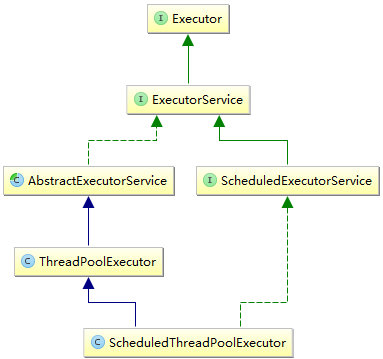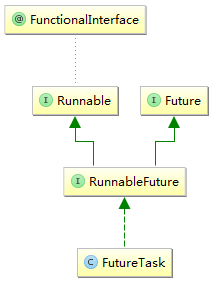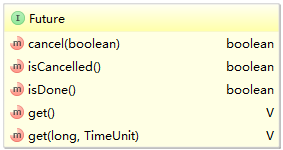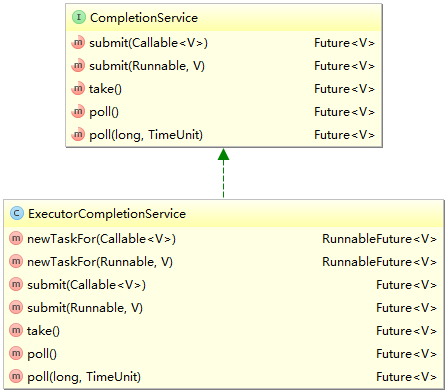java并发之线程执行器(Executor)
线程执行器和不使用线程执行器的对比(优缺点)
1.线程执行器分离了任务的创建和执行,通过使用执行器,只需要实现Runnable接口的对象,然后把这些对象发送给执行器即可。
2.使用线程池来提高程序的性能。当发送一个任务给执行器时,执行器会尝试使用线程池中的线程来执行这个任务。避免了不断创建和销毁线程导致的性能开销。
3.执行器可以处理实现了Callable接口的任务。Callable接口类似于Runnable接口,却提供了两方面的增强:
a.Callable主方法名称为call(),可以返回结果
b.当发送一个Callable对象给执行器时,将获得一个实现了Future接口的对象。可以使用这个对象来控制Callable对象的状态和结果。
4.提供了一些操作线程任务的功能
- 执行继承了Runnable接口的任务类
public class Task implements Runnable {
private String name;
public Task(String name){
this.name=name;
}
@Override
public void run() {
}
}
public class Server {
private ThreadPoolExecutor executor;
public Server(){
executor=(ThreadPoolExecutor)Executors.newCachedThreadPool();
}
public void executeTask(Task task){
System.out.printf("Server: A new task has arrived\n");
executor.execute(task);
System.out.printf("Server: Active Count: %d\n",executor.getActiveCount());
System.out.printf("Server: Completed Tasks: %d\n",executor.getCompletedTaskCount());
}
public void endServer() {
executor.shutdown();
}
}
- 执行实现了Callable<T>接口的任务
public class FactorialCalculator implements Callable<Integer> {
private Integer number;
public FactorialCalculator(Integer number){
this.number=number;
}
@Override
public Integer call() throws Exception {
int num, result;
num=number.intValue();
result=1;
// If the number is 0 or 1, return the 1 value
if ((num==0)||(num==1)) {
result=1;
} else {
// Else, calculate the factorial
for (int i=2; i<=number; i++) {
result*=i;
Thread.sleep(20);
}
}
System.out.printf("%s: %d\n",Thread.currentThread().getName(),result);
// Return the value
return result;
}
}
ThreadPoolExecutor executor = (ThreadPoolExecutor) Executors.newFixedThreadPool(2);//实例化执行器
FactorialCalculator calculator = new FactorialCalculator(number);//实例化任务
Future<Integer> result = executor.submit(calculator);//执行任务,并返回Future<T>实例
public interface Callable<V> {
V call() throws Exception;
}


public static ExecutorService newCachedThreadPool() {
return new ThreadPoolExecutor(0, Integer.MAX_VALUE,
60L, TimeUnit.SECONDS,
new SynchronousQueue<Runnable>());
}
public static ExecutorService newFixedThreadPool(int nThreads) {
return new ThreadPoolExecutor(nThreads, nThreads,
0L, TimeUnit.MILLISECONDS,
new LinkedBlockingQueue<Runnable>());
}
public static ExecutorService newSingleThreadExecutor() {
return new FinalizableDelegatedExecutorService
(new ThreadPoolExecutor(1, 1,
0L, TimeUnit.MILLISECONDS,
new LinkedBlockingQueue<Runnable>()));
}
public static ScheduledExecutorService newScheduledThreadPool(int corePoolSize) {
return new ScheduledThreadPoolExecutor(corePoolSize);
}
ScheduledExecutorService executor=(ScheduledExecutorService)Executors.newScheduledThreadPool(1);
executor.schedule(task,i+1 , TimeUnit.SECONDS);
public <V> ScheduledFuture<V> schedule(Callable<V> callable,//即将执行的任务
long delay,//任务执行前需要等待的时间
TimeUnit unit)//时间单位



ScheduledExecutorService executor=(ScheduledExecutorService)Executors.newScheduledThreadPool(1);
for (int i=0; i<5; i++) {
Task task=new Task("Task "+i);
executor.schedule(task,i+1 , TimeUnit.SECONDS);
}
executor.shutdown();
public <V> ScheduledFuture<V> schedule(Callable<V> callable,//即将执行的任务
long delay, //任务执行前需要等待的时间
TimeUnit unit) //时间单位
ScheduledExecutorService executor=Executors.newScheduledThreadPool(1);
Task task=new Task("Task");
ScheduledFuture<?> result=executor.scheduleAtFixedRate(task, 1, 2, TimeUnit.SECONDS);
public ScheduledFuture<?> scheduleAtFixedRate(Runnable command, //将被周期性执行的任务
long initialDelay,//任务第一次执行后的延后时间
long period, //两次执行的时间周期
TimeUnit unit) { //第二和第三个参数的时间单位

UserValidator ldapValidator=new UserValidator("LDAP");
UserValidator dbValidator=new UserValidator("DataBase");
// Create two tasks for the user validation objects
TaskValidator ldapTask=new TaskValidator(ldapValidator, username, password);
TaskValidator dbTask=new TaskValidator(dbValidator,username,password);
// Add the two tasks to a list of tasks
List<TaskValidator> taskList=new ArrayList<>();
taskList.add(ldapTask);
taskList.add(dbTask);
// Create a new Executor
ExecutorService executor=(ExecutorService)Executors.newCachedThreadPool();
String result;
try {
// Send the list of tasks to the executor and waits for the result of the first task
// that finish without throw and Exception. If all the tasks throw and Exception, the
// method throws and ExecutionException.
result = executor.invokeAny(taskList);
System.out.printf("Main: Result: %s\n",result);
} catch (InterruptedException e) {
e.printStackTrace();
} catch (ExecutionException e) {
e.printStackTrace();
}
// Shutdown the Executor
executor.shutdown();
public boolean validate(String name, String password) {
Random random=new Random();
try {
Long duration=(long)(Math.random()*10);
System.out.printf("Validator %s: Validating a user during %d seconds\n",this.name,duration);
TimeUnit.SECONDS.sleep(duration);
} catch (InterruptedException e) {
return false;
}
return random.nextBoolean();
}
List<Task> taskList = new ArrayList<>();
for (int i = 0; i < 3; i++) {
Task task = new Task("Task-" + i);
taskList.add(task);
}
// Call the invokeAll() method
List<Future<Result>> resultList = null;
try {
resultList = executor.invokeAll(taskList);
} catch (InterruptedException e) {
e.printStackTrace();
}
// Finish the executor
executor.shutdown();

Task task=new Task();
Future<String> result=executor.submit(task);
try {
TimeUnit.SECONDS.sleep(2);
} catch (InterruptedException e) {
e.printStackTrace();
}
System.out.printf("Main: Cancelling the Task\n");
result.cancel(true);
public V get() throws InterruptedException, ExecutionException {
int s = state;
if (s <= COMPLETING)
s = awaitDone(false, 0L);
return report(s);
}

public class ResultTask extends FutureTask<String> {
@Override
protected void done() {
if (isCancelled()) {
System.out.printf("%s: Has been cancelled\n",name);
} else {
System.out.printf("%s: Has finished\n",name);
}
}
}
1.从list中遍历的每个Future对象并不一定处于完成状态,这时调用get()方法就会被阻塞住,如果系统是设计成每个线程完成后就能根据其结果继续做后面的事,这样对于处于list后面的但是先完成的线程就会增加了额外的等待时间。
2.而CompletionService的实现是维护一个保存Future对象的BlockingQueue。只有当这个Future对象状态是结束的时候,才会加入到这个Queue中,take()方法其实就是Producer-Consumer中的Consumer。它会从Queue中取出Future对象,如果Queue是空的,就会阻塞在那里,直到有完成的Future对象加入到Queue中。

public class RejectedTaskController implements RejectedExecutionHandler {
@Override
public void rejectedExecution(Runnable r, ThreadPoolExecutor executor) {
System.out.printf("RejectedTaskController: The task %s has been rejected\n",r.toString());
System.out.printf("RejectedTaskController: %s\n",executor.toString());
System.out.printf("RejectedTaskController: Terminating: %s\n",executor.isTerminating());
System.out.printf("RejectedTaksController: Terminated: %s\n",executor.isTerminated());
}
}
public static void main(String[] args) {
// Create the controller for the Rejected tasks
RejectedTaskController controller=new RejectedTaskController();
// Create the executor and establish the controller for the Rejected tasks
ThreadPoolExecutor executor=(ThreadPoolExecutor)Executors.newCachedThreadPool();
executor.setRejectedExecutionHandler(controller);
// Lauch three tasks
System.out.printf("Main: Starting.\n");
for (int i=0; i<3; i++) {
Task task=new Task("Task"+i);
executor.submit(task);
}
// Shutdown the executor
System.out.printf("Main: Shuting down the Executor.\n");
executor.shutdown();
// Send another task
System.out.printf("Main: Sending another Task.\n");
Task task=new Task("RejectedTask");
executor.submit(task);
// The program ends
System.out.printf("Main: End.\n");
}
Main: Starting.
Main: Shuting down the Executor.
Main: Sending another Task.
RejectedTaskController: The task java.util.concurrent.FutureTask@60e53b93 has been rejected
RejectedTaskController: java.util.concurrent.ThreadPoolExecutor@5e2de80c[Shutting down, pool size = 3, active threads = 3, queued tasks = 0, completed tasks = 0]
RejectedTaskController: Terminating: true
RejectedTaksController: Terminated: false
Main: End.
Task Task1: Starting
Task Task0: Starting
Task Task2: Starting
Task Task1: ReportGenerator: Generating a report during 4 seconds
Task Task0: ReportGenerator: Generating a report during 7 seconds
Task Task2: ReportGenerator: Generating a report during 6 seconds
Task Task1: Ending
Task Task2: Ending
Task Task0: Ending
java并发之线程执行器(Executor)的更多相关文章
- java并发之线程池的使用
背景 当系统并发的线程数量很多,并且每个线程都是执行一个时间很短的任务就结束了,这样频繁创建线程就会大大降低系统的效率,因为频繁创建线程和销毁线程需要消耗大量的系统资源. 所以需要一个办法使得线程可以 ...
- Java并发之——线程池
一. 线程池介绍 1.1 简介 线程池是一种多线程处理形式,处理过程中将任务添加到队列,然后在创建线程后自动启动这些任务.线程池的基本思想还是一种对象池的思想,开辟一块内存空间,里面存放了众多(未死亡 ...
- Java并发之线程中断
前面的几篇文章主要介绍了线程的一些最基本的概念,包括线程的间的冲突及其解决办法,以及线程间的协作机制.本篇主要来学习下Java中对线程中断机制的实现.在我们的程序中经常会有一些不达到目的不会退出的线程 ...
- Java并发之线程管理(线程基础知识)
因为书中涵盖的知识点比较全,所以就以书中的目录来学习和记录.当然,学习书中知识的时候自己的思考和实践是最重要的.说到线程,脑子里大概知道是个什么东西,但很多东西都还是懵懵懂懂,这是最可怕的.所以想着细 ...
- Java并发之线程转储
一.java线程转储 java的线程转储可以被定义为JVM中在某一个给定的时刻运行的所有线程的快照.一个线程转储可能包含一个单独的线程或者多个线程.在多线程环境中,比如J2EE应用服务器,将会有许多线 ...
- Java 并发之线程安全
写线程安全的代码,说白了就是管理一个类的共享的.可变的状态.只要有多于 1 个线程对类的状态进行写入,那么就必须用同步来协调这多个线程对状态的访问.对于一个没有状态的类来说(简单的理解就是只有方法没有 ...
- Java并发之线程异常捕获
由于线程的本质特性,使得你不能捕获从线程中逃逸的异常,如: import java.util.concurrent.ExecutorService; import java.util.concurre ...
- Java并发之线程
在前面我们介绍的一些内容中,我们的程序都是一条执行流,一步一步的执行.但其实这种程序对我们计算机的资源的使用上是低效的.例如:我们有一个用于计算的程序,主程序计算数据,在计算的过程中每得到一个结果就需 ...
- Java并发之线程间的协作
上篇文章我们介绍了synchronized关键字,使用它可以有效的解决我们多线程所带来的一些常见问题.例如:竞态条件,内存可见性等.并且,我们也说明了该关键字主要是一个加锁和释放锁的集成,所有为能获得 ...
随机推荐
- WDA的配置
WDA的配置 SAP的技术总是搞得很复杂,WDA的涉及到配置如下: 1. Internet Communication Manager 确认ICM中提供的HTTP/HTTPS运行正常. Tcode: ...
- bzoj1812 [Ioi2005]riv
riv 几乎整个Byteland王国都被森林和河流所覆盖.小点的河汇聚到一起,形成了稍大点的河.就这样,所有的河水都汇聚并流进了一条大河,最后这条大河流进了大海.这条大河的入海口处有一个村庄--名叫B ...
- 博客发在oschina
国内git.oschina做的很好,看到oschina还有博客 直接导入csdn博客 http://my.oschina.net/lindexi/blog
- OpenWRT添加模块 Makefile和Config.in
添加模块编译 在网上找了一下,很多关于编译Openwrt系统的资料,不过这些事情芯片厂商提供的开发包都已经办得妥妥了,但是没有找到系统介绍的资料,添加一个包的介绍有不多,其中有两个很有参考价值: ht ...
- NodeJs之数据库异常处理
数据库异常 NodeJs版本:4.4.4 数据库链接错误 使用nodejs处理异常最麻烦不过,这里我抛开nodejs提供的domain和一些第三方库专门处理的东西.操作数据库是我们常用的功能.通过回调 ...
- 理解JDK1.5的自动装箱拆箱
JDK1.5的升级引入了装箱和拆箱概念,简单说就是为了简化书写. JDK1.5之前,创建Integer对象是需要这么写的 Integer i = new Integer("3") ...
- 启动tomcat爆错 the JRE could not be found
启动报错,如下图: 之前更改了了一个较低的jdk的版本看了看一个项目的代码,不知所云,然后再改回来, 混乱之中只要启动Tomcat就出现这种错误,还是无法找到JRE,最后如此解决: 在Windows- ...
- 数据帧CRC32校验算法实现
本文设计思想采用明德扬至简设计法.由于本人项目需要进行光纤数据传输,为了保证通信质量要对数据进行校验.在校验算法中,最简单最成熟的非CRC校验莫属了. 得出一个数的CRC校验码还是比较简单的: 选定一 ...
- MUI点击事件获取当前对象,及当前对象的属性值
//用惯了jquery,开始用mui还是有些不习惯 //直接贴代码吧 <nav class="mui-bar mui-bar-tab"> <a class=&qu ...
- linux学习(二)linux配置网卡以及常见网络问题排查
实验环境环境:mac,vmware fusion 一.常用的虚拟机网络连接模式. NAT:推荐方式.它可以使你在切换网络环境(比如在工作中和家里)时,不需要修改虚拟主机的配置,而维持正常的上网功能. ...
